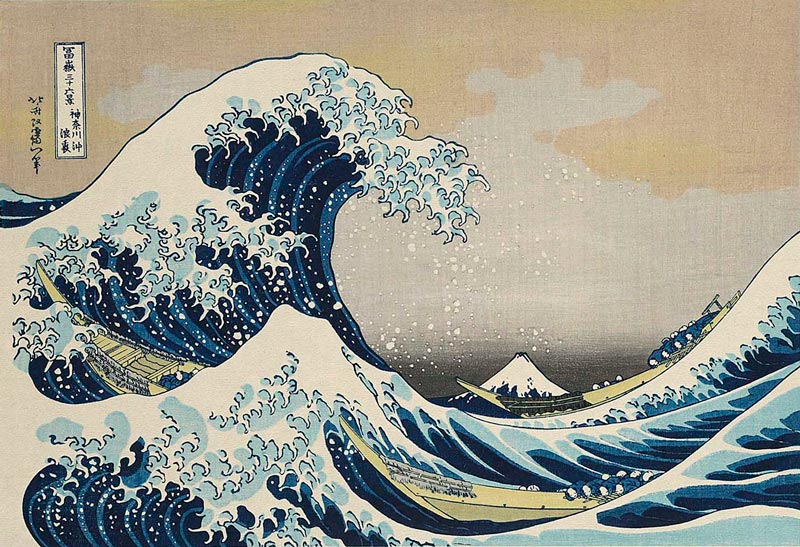葛 飾 北 斎
KATSUSHIKA HOKUSAI
富嶽三十六景
THIRTY-SIX VIEWS OF MOUNT FUJI
Contents
- About Thirty-six Views of Mount Fuji
- When was it produced?
- What is Fugaku Sanjurokkei?
- Why Mount Fuji?
- The beauty of beroai blue fascinates the world
- Highlights of the series
- Woodblock prints list
About Thirty-six Views of Mount Fuji
Series
Thirty-six Views of Mount Fuji
(Fugaku Sanjurokkei)
Artist
Katsushika Hokusai
Total number of prints
All forty-six prints
Thirty-six Views of Mount Fuji (富嶽三十六景, Fugaku Sanjurokkei) is a series of woodblock prints illustrating the various landscapes of Mount Fuji, and it is among the most famous works of ukiyo-e artist Katsushika Hokusai (葛飾北斎: 1760-1849).
The series, as a whole, is also considered to be an iconic representation of the landscape ukiyo-e genre.
Many of you may recognize some of the pieces even if you aren’t familiar with their exact titles.
The famous print of the Great Wave is known to many people around the world, but it is just one of the 46 scenes in the series.

With these intriguing facts, it’s no wonder people around the world find Hokusai’s famous landscape series so inspiring. Of the series, the three prints Under the Wave off Kanagawa (神奈川沖浪裏, Kanagawa Oki Nami Ura), Rainstorm Beneath the Summit (山下白雨, Sanka Hakuu), and South Wind, Clear Weather (凱風快晴, Gaifu Kaisei) are collectively called the Sanyaku (三役, three major works) and have acquired high acclaim both in Japan and abroad as works of exceptional artistic quality.

Under the Wave off Kanagawa (神奈川沖浪裏, Kanagawa Oki Nami Ura)

South Wind, Clear Sky (凱風快晴, Gaifu Kaisei)

Rainstorm Beneath the Summit (山下白雨, Sanka Hakuu)
Highlights of the series

1. Beroai
Most of the works of the Mount Fuji series are painted using beroai, and of those prints, ten are aizuri-e, a type of ukiyo-e printed in varying shades of beroai blue.
Aizuri-e is a type of ukiyo-e printed only with different tints and shades of blue or with minimal use of an additional red and/or yellow.
List of Woodblock Prints No.10 to No.20

2. Hokusai’s mastery of artistic expression
The woodblock prints capture the various facets of Mount Fuji as it shifts its appearance at every moment depending on the location, season, and weather condition. However, you would not be able to pinpoint the actual location even if you stood at the supposed site of the landscape art, meaning that not all the sceneries depicted in the prints were true to life. Many of the works are said to be created through Hokusai’s elaborate imagination inspired by actual views and past works of landmark impressions. What gives this idyllic series its distinct character is that Hokusai depicted Mount Fuji with his remarkable composition skills and mastery of artistic expression. He intentionally altered the arrangement of the pictorial elements to capture the beauty and ferocity of nature.

3. Use of perspective
In the Edo period, ukiyo-e artists typically used tints and shades of colors to create depth; however, in this series of prints, Hokusai introduced the European art style of perspective.
Almost all of the prints in the Thirty-six Views of Mount Fuji were produced with perspective.
Hokusai artfully employed perspective and a variety of other techniques to highlight Mount Fuji, the primary subject matter, in its full glory.
Hokusai creatively experimented with and adopted daring compositions, eccentric ideas, and many other artistic innovations to keep people engaged in the Thirty-six Views of Mount Fuji.Fugaku Sanjurokkei is a treasure trove of masterpieces. Do enjoy all 46 idyllic impressions of Mount Fuji created by Hokusai.
We are currently preparing an introductory page for each print in the Fugaku Sanjurokkei series.For those interested, we will send an email notification for each artwork as soon as the page is completed. If you would like to be notified by email, please sign up using the registration form below.You only need your email address to sign up. (Registration is free.)
List of Woodblock Prints
Stay tuned for updates.

No,1
Under the Wave off Kanagawa also known as The Great Wave off Kanagawa
神奈川沖浪裏, Kanagawa Oki Nami Ura

No,32
Viewing Sunset over the Ryogokubashi Bridge from the Onmayagashi River Bank
御厩川岸より両国橋夕陽見, Ommayagashi Yori Ryogokubashi Sekiyou Wo Miru

No,36
Simplified View of Tagonoura Beach at Ejiri on the Tokaido Road
東海道江尻田子の浦略図, Tokaido Ejiri Tagonoura Ryakuzu

No,38
Mount Fuji seen in the Distance from Senju Pleasure Quarter
従千住花街眺望ノ不二, Senju Hanamachi Yori Chobo No Fuji

No,39
Mount Fuji from Gotenyama at Shinagawa on the Tokaido Road
東海道品川御殿山ノ不二, Tokaido Shinagawa Gotenyama No Fuji

No,41
Mount Fuji from the Tea plantation at Katakura in Suruga Province
駿州片倉茶園ノ不二, Sunshu Katakura Chaen No Fuji








































